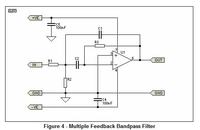Follow along with the video below to see how to install our site as a web app on your home screen.
Note: This feature may not be available in some browsers.
siewfai2101 said:thanks for replying me!!
so is it just using
1/(2*pi*R21*C21*R22*C22) ???
As far as I see, it's not achieved exactly, actual values are 290 Hz, 3.42 kHz and 7.28 kHz.i still cant manage to get da value indicated such as 350Hz, 4kHz, and 9kHz..
As far as I see, it's not achieved exactly, actual values are 290 Hz, 3.42 kHz and 7.28 kHz.
Personally, I don't see much sense in using the term center frequency with a high-pass/low-pass combination. It's not more than an arithmetic mean, but a well defined property of course.
 [/img]
[/img]